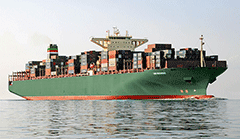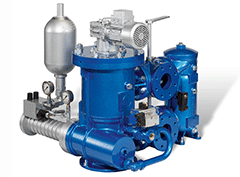Autarkic hydraulics for rinsing function of large automatic filters on large engines
- Details
- Hits: 10078
 As part of an innovation offensive, Mahle further developed the "COM plus" series of fuel filters for large engines operated with heavy fuel oil. For this purpose, the rinsing function of the automatic cleaning was switched from an electromechanical to a hydraulic drive. Bott's hydraulic experts found a clever solution that reliably and independently supplies the huge motors with fuel while the filter is being cleaned. For the economical and ecologically advanced automatic filters in the hot circuit, the globally unique solution is a real competitive advantage and a great reassurance for shipowners.
As part of an innovation offensive, Mahle further developed the "COM plus" series of fuel filters for large engines operated with heavy fuel oil. For this purpose, the rinsing function of the automatic cleaning was switched from an electromechanical to a hydraulic drive. Bott's hydraulic experts found a clever solution that reliably and independently supplies the huge motors with fuel while the filter is being cleaned. For the economical and ecologically advanced automatic filters in the hot circuit, the globally unique solution is a real competitive advantage and a great reassurance for shipowners.
"If a ship's engine fails and the ship is unable to maneuver, it becomes the property of the person who hooks the ship," says Manfred Schnell, describing the laws of international maritime law. "With a container ship, the shipowner would lose the cargo, which usually costs tens of millions of euros." The head of product management for automatic filters at Mahle Industriefiltration in Öhringen is jointly responsible for ensuring that the fuel filters do not become the cause of engine damage. In close cooperation with Wolfgang Bott GmbH & Co. KG, a hitherto unique, self-sufficient hydraulic solution was created which not only initiates backwashing and supplies clean and preheated fuel to the engine, but also discharges the cleaned sludge into the tank provided.
Filters for heavy fuel are key
Since fuel filter in the operated with heavy oil Large engines, such as those used in ocean giants, are a key driver for the supply of fuel take, they have to work absolutely smoothly and reliably. The COM plus fuel filters filter the highly viscous heavy oil that was previously reduced to up to 150 °C and prepare the fuel for the large engines through high degrees of separation and innovative filter cleaning technology. With this absolute filtration, the smallest particles of up to 10 µm are retained. The regular cleaning of the filter is supported by a hydraulic system developed by the experts from Bott developed in record time have, The automatically starting, self-sufficient system provides at the maximum backwashing 5 l Rinsing fluid that during the cleaning process pressure and flow of the fuel does not break. "Otherwise, the huge diesel engine would start stuttering quickly," explains industrial design manager Albert Schick of Mahle Industriefiltration.
 Servo hydraulics instead of hydraulics: calculator and new developments
Servo hydraulics instead of hydraulics: calculator and new developments
As part of a product development, the project-responsible team from Flintbek and Öhringen wanted to move away from the predecessor solution with electromechanical drive for filter cleaning. Schick explains why: "The new solution should work reliably with powerful hydraulics, making the entire filter simpler and more compact, easier to assemble and maintain and, at the same time, more cost-effective." "Reliable functioning is our top priority", adds Fast.
Rough seas require more frequent backwashing
 The cleaning of the filter fabric starts with the fuel filters of the COM plus series, which are available in three sizes, either cyclically according to set time intervals or variably after reaching an adjustable differential pressure mark. The variable triggering is important because, depending on the operating situation of the engine, backwashing may be necessary sooner or later. For example, when a container ship starts with a departure and Turning maneuvers in the harbor all 5 to 10 min a cleaning will be necessary, as this much fuel flows through the filter. "Even rough seas require more frequent rinsing," explains Markus Pracher, "because then rocked sediments contaminate the fuel before filtering more than in calm seas," continues the Mahle design engineer. During normal driving in calm seas, the filter rinses about once an hour.
The cleaning of the filter fabric starts with the fuel filters of the COM plus series, which are available in three sizes, either cyclically according to set time intervals or variably after reaching an adjustable differential pressure mark. The variable triggering is important because, depending on the operating situation of the engine, backwashing may be necessary sooner or later. For example, when a container ship starts with a departure and Turning maneuvers in the harbor all 5 to 10 min a cleaning will be necessary, as this much fuel flows through the filter. "Even rough seas require more frequent rinsing," explains Markus Pracher, "because then rocked sediments contaminate the fuel before filtering more than in calm seas," continues the Mahle design engineer. During normal driving in calm seas, the filter rinses about once an hour.
In January 2011, the project team was looking for a competent manufacturer for the hydraulic solution and was deliberately not looking for a dealer who should not be too far away. One quickly came across the experts from Bott in Mössingen. “We should develop a reliable hydraulic solution for backwashing in a very short time and bring it to series production,” remembers Markus Haist, technical manager at Bott. “An extremely demanding task.” A filter with the hydraulic drive delivered in June was convincing and was installed in one of the world's largest container ships in August. With every 3 1/2 s flushing process, five liters of preheated fuel are pressed from the compensator into the filter while at the same time the cylindrical single or double filter with pleated filter insert and up to 22.000 cm2 Surface through a circulating rinse nozzle with a differential pressure of Δ p 0,5 bar over the 16 bar nominal pressure is cleaned.
Self-sufficient system without external energy supply
The self-sufficient drive system works without external energy supply on a hydro-pneumatic basis by a medium-filled pressure accumulator is connected via a connecting rod with the piston in the compensator. This piston separates the fuel side from the dirty side and acts as a passive piston. The process is regulated solely by a switching valve and two throttles for fine adjustment of the adjustment times. With this design, the system requires no external energy. This eliminates the need for complex control as well as extensive sensor technology. On the one hand, this solution lowers the production costs and, on the other hand, ensures a stable and reliable on-going and expiring backwashing process. The reliability and reliability increases significantly compared to electromechanical solutions. In addition, the system is much easier to maintain.
Similar to a shock absorber, the system is preloaded in a maximum of 40 s by the compensator fills with clean fuel. When the preset time is reached or the preselected difference between dirty side entry pressure and clean side discharge pressure is exceeded, the flushing amount from the chamber is forced into the filter and at the same time the opening half of the chamber is filled with cleaned up sludge. Then the drive of the compensator pushes the dirt side empty and at the same time fills the clean side with cleaned fuel. The system is excited again for the next flush. Developer Haist explains the completely self-sufficient process as follows: "The storage system uses the pressure conditions in the system to fill the buffer as well as to dispense the fuel into the filter for the backwashing process."
Worldwide unique: preheated rinsing fluid
All this happens while the filtration process continues, with no noticeable pressure drop or reduction of the flow rate. Until the next cleaning process, the fuel remains preheated in the compensator. Preheating the fuel in the compensator is unique in the world and ensures trouble-free flushing. "Likewise, we are not aware of a system that only uses 5 l rinsing fluid," emphasizes Pracher. Haist describes one advantage: "This allowed us to build the entire assembly in a very space-saving manner." "That makes the filter installation a lot easier," confirms Schnell, who has fulfilled a central requirement. Because the Fuel filter COM plus With the self-sufficient backwash function can be used directly in the hot cycle, the operators save the filter in the cold cycle in conjunction with a so-called police filter in a hot circuit.
